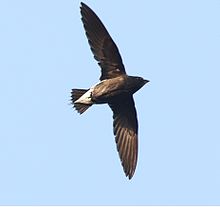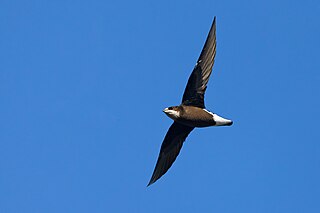
The white-throated needletail, also known as needle-tailed swift or spine-tailed swift, is a large swift in the genus Hirundapus. It is reputed to reach speeds of up to 170 km/h in horizontal flight, but this is unverified because the methods used to measure its speed have not been published.

The ruddy-breasted crake, or ruddy crake, is a waterbird in the rail and crake family Rallidae.

The Asian palm swift is a small swift. It is very similar to the African palm swift, Cypsiurus parvus, and was formerly considered to be the same species.

The Indian swiftlet or Indian edible-nest swiftlet is a small swift. It is a common resident colonial breeder in the hills of Sri Lanka and south west India.

The crested goshawk is a bird of prey from tropical Asia. It is related to other diurnal raptors such as eagles, buzzards and harriers, and thus placed in the family Accipitridae.

The black-headed ibis, also known as the Oriental white ibis, Indian white ibis, and black-necked ibis, is a species of wading bird of the ibis family Threskiornithidae which breeds in the South and Southeast Asia from India to the west and as far east as Japan. It is the only native ibis species in its range that has an overall white plumage with a black neck and head. The down-curved beak and legs are also black. Though often referred to as a wetland species, the black-headed ibis forages in a range of natural and man-made habitats. This species of ibis nests only during the rainy season.

The collared scops owl is an owl which is a resident breeder in south Asia from northern Pakistan, northern India, Nepal, Bangladesh, the Himalayas east to south China, and Taiwan. It is partially migratory, with some birds wintering in India, Sri Lanka and Malaysia. This species was formerly considered to be included within what is now separated as the Indian scops owl.

The Sri Lanka hanging parrot is a small parrot which is a resident endemic breeder in Sri Lanka.
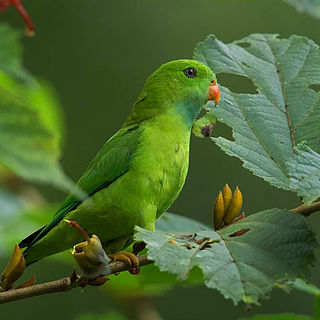
The vernal hanging parrot is a small parrot which is a resident breeder in the Indian subcontinent and some other areas of Southeast Asia. It undergoes local movements, driven mainly by the availability of the fruit, seeds, buds and blossoms that make up its diet. They frequent the banyan tree for the fruit and plantain trees for the nectar from the flowers.

The Indian scops owl is a species of owl native to South Asia.

The chestnut munia or black-headed munia is a small passerine. It was formerly considered conspecific with the closely related tricoloured munia, but is now widely recognized as a separate species. This estrildid finch is a resident breeding bird in Bangladesh, Brunei, Cambodia, China, India, Indonesia, Laos, Malaysia, Burma, Nepal, the Philippines, Singapore, Taiwan, Thailand, Vietnam and Hawaii. It also has been introduced to all the Greater Antilles and Martinique in the Caribbean.
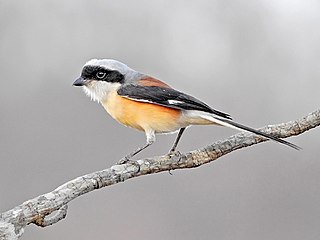
The bay-backed shrike is a member of the bird family Laniidae, the shrikes, resident in South Asia.

The Sri Lanka spurfowl is a member of the pheasant family which is endemic to the dense rainforests of Sri Lanka. In Sri Lanka, this bird is known as haban kukula - හබන් කුකුලා in Sinhala.
The purple needletail, or hagibas in Tagalog, is the largest swift found in the Old World. It is native to the Philippine archipelago and the Minahasa Peninsula (Sulawesi).
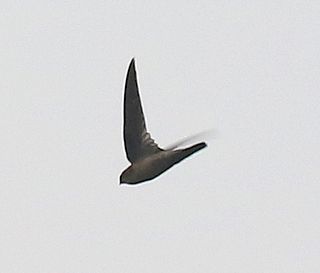
The Himalayan swiftlet is a small swift. It is a common colonial breeder in the Himalayas and Southeast Asia. Some populations are migratory.

The silver-backed needletail is a species of swift in the family Apodidae. It is found in Southeast Asia, Sumatra, Java and Taiwan. It is a vagrant to Christmas Island. Its natural habitat is subtropical or tropical moist lowland forests.

Hirundapus is a genus of swifts in the family Apodidae. The name Hirundapus is constructed from the names of the swallow genus Hirundo and the swift genus Apus.
H. giganteus may refer to:

The Apodinae are a subfamily of swifts and contain the following species:
